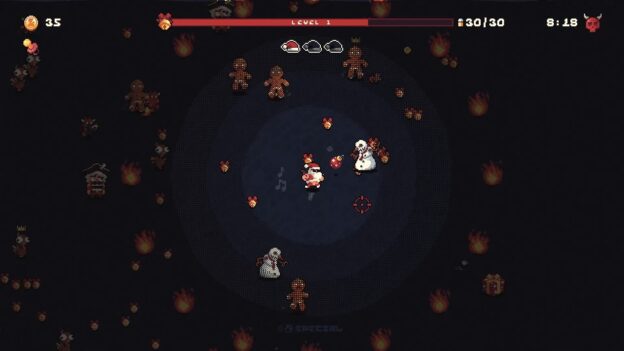In Stars And Time Review – Review

In search of lost time loops.
2D RPG In Stars and Time is a genuinely unique blend of genres, feeling something like a cross between Undertale and Minit. It features a turn-based combat system, heavy amounts of dialogue (especially for its slight world), an almost roguelike time loop mechanic, and a smallish four-floor dungeon at its center. What it lacks in breadth it makes up for with charming characters and dialogue, but the in-baked repetition does start to wear thin about halfway through its 10 to 15-hour runtime.
The game opens in a field, with protagonist Siffrin struggling to wake up from a nap. The story sees Siffrin and his friends–Mirabelle, Odile, Bonnie, and Isabeau–near the end of their journey to defeat The King, a villain who has been freezing time for nearby citizens. The in medias res narrative allows the soon-to-be introduced time loop mechanic to take center stage, with the heroes spending one final night sleeping over at the nearby clock tower before entering the King’s lair.

The four-floor house contains enemies to engage, locked doors to open, and items to collect. You can generally avoid most basic enemies by skirting around them in the hallways, but encounters with mini-bosses and bosses cannot be avoided. One of the first events you encounter involves a giant boulder falling from the ceiling and crushing Siffrin, and it’s at that point that the time looping comes into play. Each trap you trigger in the dungeon gives you information about how to avoid it in future runs. You’ll learn the location of keys so that you can immediately retrieve them and continue on your way towards the final battle. Eventually, you’ll access the ability to open all doors of a floor before looping back there, which cuts down on backtracking. An unfortunate aspect of the time manipulation is that there’s a currency involved with skipping ahead in later runs, and accumulating more of it feels like a chore.
A creature known as Loop plays the role of handler, guiding you through the game and offering hints about what to do next. You can find them in the town area at the beginning of the game, but later on you’ll be able to call them from a distance. There are ways to reduce the amount of looping (and thus saving a fair bit of in-game time) by just saving your game before choosing from the forks in your path. You’re meant to succeed through some trial and error, but having to push through all the dialogue and even the tutorial battle that come with looping back to the very start of the game is fairly tedious.

What helps with the repetition built into a game of this type is that you do gradually open up new dialogue options with your party members. One of your first objectives is to inform your comrades in town of the sleepover to come that night, and it’s during this sequence that Siffrin is able to use some of their previously acquired knowledge to ask different questions and get to know their mates a little bit better. The townsfolk can also offer hints and information to assist you with obstacles encountered in the dungeon, too. That said, In Stars and Time does sometimes feel like a larger game trapped in a smaller one, and so there’s a disconnect between what you need to do to reach the end and what optional tasks you can take on. It doesn’t help that the second half of the adventure forces you to juggle multiple objectives without really giving the progression or record-keeping tools to manage them.
The turn-based combat uses rock-paper-scissors (RPS) as a replacement for elements or typing. Rock attacks are strong against scissor enemies but ineffective against paper foes, and so on. The enemy designs are abstract but forgettable, aside from needing to spot a part of their body that indicates their RPS type, often their hands. Noticing that a foe’s mitts are in the shape of a pair of scissors means you’ll want to use Isabeau’s rock attacks or Odile’s rock spells. You can level up, albeit slowly, to earn an extra ability or two over the four or five you start the game with, and given the challenging final boss fight, it’s worth stockpiling items and not avoiding too many combat encounters.

I’m torn when it comes to the cast and dialogue of In Stars and Time. As individuals and as a group, I like how different they are and how they express their personalities. However, even searching basic elements of a room, like a closet or a bookshelf, can result in lengthy discussions amongst the party. These interactions go on longer than they need to, and there are so many of them that I stopped searching locations thoroughly to avoid the overlong conversations that would undoubtedly ensue. A better balance between gameplay elements and dialogue would have likely resulted in a more enjoyable experience overall.
While it doesn’t persist throughout the entire playthrough, there’s an unmistakable uniqueness to In Stars and Time. Its parts may be stronger than it ends up as a whole, but there’s humor and heart pouring from its cast. While the back half features some interesting twists, with them come more repetition and occasional frustration with how character and area progression occurs. Even though it’s a little too verbose, the overall experience of In Stars and Time is a worthwhile one, especially for fans of Undertale and other offbeat RPGs.




